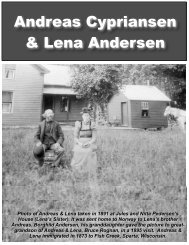Viking Heraldy of Lewis & Cinda - Bruce Rognan
Viking Heraldy of Lewis & Cinda - Bruce Rognan
Viking Heraldy of Lewis & Cinda - Bruce Rognan
You also want an ePaper? Increase the reach of your titles
YUMPU automatically turns print PDFs into web optimized ePapers that Google loves.
5. Thore Sudreim Jonsdatter<br />
John Raud Ivarsen was instrumental in Rostock became a leading center <strong>of</strong> teaching the importance <strong>of</strong> the<br />
Reformation. It was here that the University <strong>of</strong> Rostock was established, and over a dozen generations <strong>of</strong> the<br />
Flor family and Haftore Jonsson’s descendants attended. Agnes and Haftore, where their descendants remain<br />
in the area <strong>of</strong> Akershus and become royal land owners. Agnes married Haftor Jonsson, whose paternal ancestors<br />
for 5 generations had ruled and controlled all <strong>of</strong> Romerik as small tributary sherriffs, or earls, granted that<br />
right by King Harald Gille.<br />
Haftore Johnsson Sudreim. One <strong>of</strong> the most prominent chieftain families at that time was the Sudreim family<br />
from Sørom in Romerike. Even though the family<br />
made their money from mercantilism / foreign trade,<br />
as was the custom, these captains <strong>of</strong> the sea in England<br />
and italy and Norway, all lived inland, although<br />
acce4ssible to the sea. Haftor Jonsson was born at<br />
Sudreim, Akershus in 1275 . In 1302 he married Agnes,<br />
daughter <strong>of</strong> King Håkon V, and their descendants<br />
were leaders in Norway for a long time. Their son, Jon<br />
Haftorsson, was married to the Swedish noblewoman<br />
Birgitta Knutsdaughter <strong>of</strong> the Folkung family. Their<br />
son Ulv Jonsson was the progenitor <strong>of</strong> the Swedish<br />
noble family <strong>of</strong> Roos at Ervalla. Ulv was a leading<br />
man in the Swedish revolt in 1434.<br />
Sigurd Haftorsson took over Sudreim after his brother<br />
Jon Haftoresson. The daughter <strong>of</strong> Sigurd, Agnes Sigurdsdaughter<br />
was married to the Swedish nobleman<br />
Jon Marteinsson who settled on Sudreim and became<br />
a member <strong>of</strong> the Norwegian National Council. Their<br />
son, Sigurd Jonsson, became the Norwegian Drottsete<br />
in 1439, the first in many years.<br />
Haftore was the Kings representative in handling the Hanseatic League (map <strong>of</strong> hanseatic cities at right), the<br />
powerful shipping Empire out <strong>of</strong> Luebeck, Germany. Haftore also negotiated treaties with Roger de Flor, the<br />
most powerful naval commander <strong>of</strong> the Mediterranean Sea, co-emperor <strong>of</strong> the Byzantine Empire, leader in the<br />
final crusade <strong>of</strong> 1291, and also a religious zealot who had no tolerance or respect for the papal <strong>of</strong>fice. It is no<br />
coincidence, that Roger de Flor’s “wappen” (Coat <strong>of</strong> Arms) is identical with Roger de Flor’s. Both were 4 th generation<br />
descendants <strong>of</strong> Floris <strong>of</strong> Holland. Haftore also worked with Oliver Gautier Flor <strong>of</strong> Netherlands, who was<br />
a leader <strong>of</strong> the Hansetic League, which gained its dominance immediately after the last crusade at ther Fall <strong>of</strong><br />
Acre in 1291.<br />
The coat <strong>of</strong> arms <strong>of</strong> Haftor Jonsen is a very significant part <strong>of</strong> the story in the family. The 5 pedaled rose as a<br />
coat <strong>of</strong> arms was first known to have been developed shortly after the first crusade. It became a symbol <strong>of</strong> solidarity<br />
among those who embraced it as a family crest. The first known usage <strong>of</strong> the 5 pedaled rose was the<br />
“Flor family” <strong>of</strong> Cambrai, France, which was also adopted by the House <strong>of</strong> Holland. In the 5 volume 2000 page<br />
history <strong>of</strong> the Flor Family (325 AD - 1600 AD), that I published in 2006, there are some basic themes that<br />
tended to be a pattern <strong>of</strong> the Flor family. At the time <strong>of</strong> the crusades the Flor family controlled the military orders<br />
<strong>of</strong> “Hospitallers” and the Knights Templar”. They used incredible influence to shift the focus <strong>of</strong> these military<br />
orders to be economic / banking and trade orders. At the conclusion <strong>of</strong> the last crusade in 1291, the family<br />
converted their empire from using their boats to waging war, to instead promoting economic development. They<br />
became involved in the controlling the distribution <strong>of</strong> imports and exports in the following ports:<br />
1. Florence, Italy (Pisa)<br />
2. Kings Lynn (York), England<br />
3. Trondheim, Bergen and Oslo Norway<br />
4. Flanders (Germany, France, Belgium, Netherlands)<br />
5. At everyone <strong>of</strong> these ports a Flor family member was present.<br />
The Flor family was part <strong>of</strong> an elaborate secret order <strong>of</strong> Hospitallers, spread throughout Western Europe to<br />
safegard themselves against the popeʼs power. The 5 pedaled rose also became their symbol. They were very<br />
strong in the above four cities, and in all <strong>of</strong> their trading, they neglected to pay the pope <strong>of</strong> any tithes due him<br />
during their transactions.



